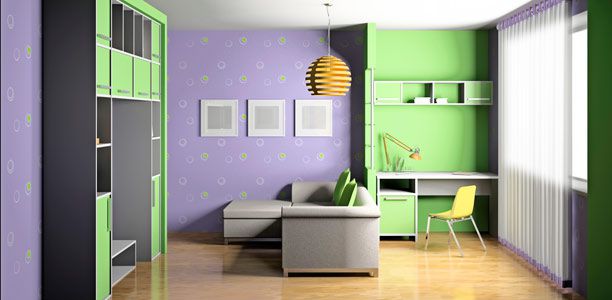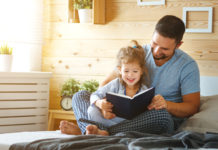Whatever age your child is and regardless of the size or shape of their room, there are a few essentials to consider before you start.
1. Involving your child in decision making
Involving your child in decision making is an important step in helping them develop into independent, responsible adults that can do things for themselves. While your child’s age will influence the extent to which they are able to make decisions about, for example, the colour of the room or where their bed should go, a bedroom makeover is a great opportunity to involve you child in making decisions.
2. Lighting it up
You child’s bedroom is not only the place they sleep. They’re also likely to spend considerable amounts of time playing, relaxing and reading in their room. Lighting helps create the mood of the room but also defines it’s practical uses- that psychedelic purple and green patterned light your fifteen year old can’t live without for her Saturday night sleep over may have an important place in her life right now, but has no place during study time!
When thinking about the lights in your child’s room:
- Ensure you include a good reading light beside the bed and in the study area (it could be the same one, depending on the layout of the room). Good reading light is essential and placing it close to the bed will encourage your child to read before bed and make it easy for you to read to them.
- A new shade on the ceiling light or a lamp is a great way to revamp a tired looking room.
- A dim light beside the bed might be good to use when putting a young child to sleep.
- Light switches should be easy to access if you need them in the night, for example if your child wets the bed.
3. Using space wisely
Whatever size your child’s bedroom, you probably wish it was just a bit bigger. Space is an important consideration when making over your child’s bedroom. Whatever space you have, it’s important to use it wisely, particularly if the room is small. But there are plenty of creative ways to create unique storage areas from space that would otherwise be wasted.
Measuring the room and making a plan on paper before you start can save time and energy- instead of shifting furniture back and forward to see if it fits (and probably banging and scraping a few walls in the process) you can see what fits where using the measurements of walls and different pieces of furniture. When you are happy with the plan on paper, use masking tape to mark it out on the floor of the room. Ask your child to help and when you’ve finished walk around the room together and imagine what it will look like when all the furniture is back in place. They’ll love letting their imagination run wild.
Planning the room can also help ensure you make good use of the space you’ve got. For example, you may want to divide it into areas for play and sleep, so your child’s toys are away from and do not clutter their bed. If you’re short on space, plan the areas of the room so that they’re multi-purpose, for example you can have some extra pillows so that a child’s bed can also be used as a snuggly reading couch during the day. If your children are sharing a bedroom, you may want to plan the room so that they each have their own spaces, for example separate cupboards to store their clothes. You could also make spaces for play mats which each child sharing a room can use as their personal play zone.
4. Deciding what goes in
There may be some hard decisions to make about what goes into your child’s bedroom, and the size of the room is not the only thing you’ll need to consider when making your decision. Think about everything you’d like to put in your child’s room (and whether or not you’ll need to add or remove things in the next few years) when you begin planning your makeover. Work out what’s essential and what would be nice if it fits. Consider what bedroom furniture you’ve already got and if you can revamp it, or if you can afford to splurge on a new/pre-loved item or furniture or two. If the room is small, you’ll need to think creatively about how you can maximise the space, for example by making under the bed a storage area, or utilising space that’s unused, for example higher up the walls.
What to put in your child’s bedroom
What you fill the bedroom space up with will depend a lot on your child’s age and interests. If you’ve got a newborn baby you’ll need to prioritise bedroom items like a cot, change table and storage for all the baby essentials. Toddlers and pre-schoolers will need somewhere to store their toys, a play area and a bed. Older children will need space to play or relax and an area to study with good lighting.
What not to put in your child’s bedroom
Choosing what you won’t put in your child’s bedroom is another important decision which can help you use the available space wisely. This will also depend on their age and interests, but if you want to reduce your child’s risk of overweight and obesity, evidence shows that no-TV-in-the-bedroom is a good decision to make.
To find out more about the effects of TV on child development see TV and Kids: What really happens when you turn on the TV?
5. Choosing colours
Choosing a colour for your child’s room may be difficult, and a good place to start is checking your child’s preference. While there are plenty of theories on the effects of colour (on everything to a person’s mood to how fast their heart beats), there’s not much evidence. The effects of colour appear to be fairly minor and immediate (for example even if red is a stimulating colour, it probably only stimulates for a few seconds). So the colour you choose for their room probably won’t make much difference to their brain or their body.
Society attaches different meaning to different colours. For example, white is associated with purity and cleanliness, while red is exciting. This may also influence the choice of colour, for example some may choose to paint a girl’s room pink because it is often thought of as a girl’s colour (while others may choose not to paint a girl’s room pink for the same reason).
6. Making the room safe
While we all want our kids’ rooms to look great, safety is even more important. When planning your child’s room there are a few things to consider for making it safe:
- Don’t hang anything above the bed. It may fall down and injure them while they’re sleeping.
- Cover all electrical sockets.
- Install a smoke detector- it is recommended that every bedroom in the house has a smoke detector.
- Choose curtains and bedding that are made of fire resistant fabric.
 |
Find out more about bedroom makeovers for kids |
References
- Western Australia Department of Fire and Emergency Services. Installing Smoke Alarms. 2013. (cited 13 October 2013). Available from URL Link.
- Jeppson, J. Myers-Walls, JA. Children and Colours. Purdue University Parent-Provider Partnerships. 2013. (cited 13 October 2013). Available from: URL Link.
- Responding to colour. Cooperative Extension Service- University of Kentucky. 2001 (cited 13 October 2013). Available from: URL Link.
- Staiano, AE. Harrington DM. Broyles ST. et al. Television, adiposity and cardiometabolic risj in children and adolescents. Am J Preventive Med. 2013. 44(1): 40-47. (Abstract)
- Willis, C. Decision making- the foundation of responsible behaviour. University of Arizona. 1999. (cited 14 October 2013). Available from: URL Link.



 (9 votes, average: 4.56 out of 5)
(9 votes, average: 4.56 out of 5) 






